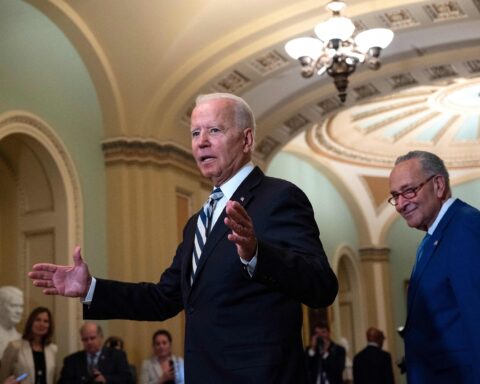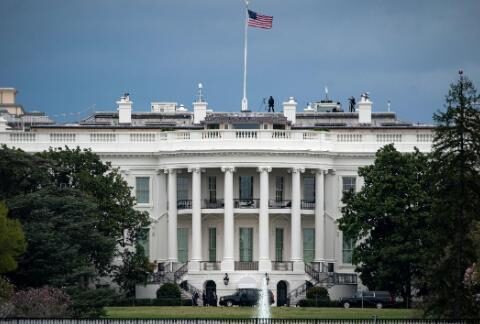Just as Democrats face another round of hand-wringing about their erosion among working-class and rural White voters — after last week’s daunting election results in Virginia and New Jersey — the long-delayed congressional approval of a historic infrastructure plan will test President Joe Biden’s central theory on how the party can reverse that decline.
Biden and many of his advisers have long argued the best way for Democrats to regain ground with blue-collar voters — not only the White ones, who have drifted toward the GOP since the 1960s, but also increasingly Hispanic and even some Black ones — is to show that government can deliver them material benefits.
The bipartisan infrastructure plan, which Biden calls a “blue-collar blueprint to rebuild America,” constitutes one prong of that plan, with spending designed to spur employment in such working-class occupations as construction, energy retrofits and manufacturing; the other prong is the massive spending bill the President still hopes to steer through Congress solely with Democratic votes by Thanksgiving. That proposal, experts say, tilts its benefits heavily toward working-class families across racial lines, including subsidies for child care and health care and an expanded child tax credit, as well as programs that would support potentially more than 1 million caregiving jobs. Just as importantly, the plans fund these new benefits primarily with higher taxes on corporations and the most affluent.
In an extensive new study of working-class attitudes released last Friday, the veteran Democratic pollster Stanley B. Greenberg and firms specializing in Black and Hispanic voters argue that the combination — new benefits for economically squeezed families, funded by confronting groups that have benefited from increasing economic inequality — provides Democrats their best chance to improve with blue-collar voters of all races.
“This polling and this collaboration is a wake-up call that says these people are desperate to have someone battle for them,” says Greenberg, who became renowned in the mid-1980s for documenting the alienation from the Democratic Party of White blue-collar “Reagan Democrats” in Macomb County, outside Detroit. “They are only there [electorally] if you want to change the power balance … if you want to make real big economic change, and you really understand their lives. And it’s been a long time since they have seen that from Democrats.”
But the depth of the hole Democrats face with working-class White voters was underscored by last week’s election losses in Virginia, where exit polls showed Republican gubernatorial nominee Glenn Youngkin, a wealthy former private equity executive, winning about three-fourths of Whites without college degrees, and in New Jersey, where the longtime Democratic president of the state Senate was swept away in a heavily blue-collar district by a Republican truck driver who had never before sought office.
To many analysts, those outcomes underscore how many cultural barriers still limit Democrats among White blue-collar voters, even if they can deliver more kitchen-table assistance.
“There are a lot of things that are in the reconciliation package that will be very beneficial … to the White working class and non-White working class,” says Alan Abramowitz, an Emory University political scientist who recently published a study on attitudes among working-class White voters. “But it doesn’t seem to matter, because it’s not what they are voting on. What they are voting on is that they are much more closely aligned with Republicans across a whole range of issues, that arrays from cultural issues that get a lot of play to racial issues, immigration.”
Virtually no analyst in either party believes that Democrats, whatever strategy they follow, can win a majority of working-class White voters. (No Democratic presidential candidate has done so since Lyndon Johnson in 1964, polls show). But the difference between a normally disappointing midterm for the party holding the White House and a catastrophic result that could lock Democrats out of congressional power for years may come down to whether they can regain any ground with working-class voters of all races from the direct economic benefits that the infrastructure plan will deliver — and that the reconciliation plan could deliver if Democrats overcome the intractable internal disagreements that have stalled its approval for months.
Tracking Democratic erosion
White voters without four-year college degrees functioned as the brawny backbone of the Democrats’ “New Deal” electoral coalition from the 1930s through the 1960s. The party’s erosion with those voters after that, largely around issues of racial equity and cultural change, generated enormous alarm and internal debate during the 1970s and especially 1980s: The centrist “New Democrat” movement led by Bill Clinton was sparked mostly by the desire to win back more blue-collar and rural Whites.
From roughly 1992 through 2008, Democrats settled into a sustainable equilibrium with these voters. In national exit polls over that period, Democratic presidential candidates consistently won only about two-fifths of them, but they typically captured significantly higher percentages in the key Rust Belt battleground states (such as Michigan, Wisconsin and Pennsylvania). Over this period, Democrats were able to overcome their deficits with working-class Whites in the Rust Belt and beyond by maximizing their performance among college-educated White voters and people of color, both of whom were growing as a share of the electorate, while blue-collar Whites were shrinking nationally on average about 2 to 3 percentage points every four years. (Those working-class Whites have fallen from about 52% of all voters in 2004 to just under 40% last year, according to census results.)
But since 2012, Democrats’ position with these working-class White voters has slipped further, in a manner that has grown more difficult to overcome with improved performance and turnout among other groups, especially in less diverse industrial battlegrounds. The Democrats’ national vote share among them fell to a little over one-third in President Barack Obama’s 2012 election before cratering to just below 30%, according to multiple data sources, in Donald Trump’s 2016 victory over Hillary Clinton; as important, Trump erased enough of the Democratic blue-collar overperformance in Michigan, Wisconsin and Pennsylvania to capture all three states and squeak out his Electoral College win while losing the national popular vote.
In 2020, Democrats slightly recovered among non-college-educated White voters, with Biden winning about one-third of them nationally and recapturing just enough to help flip back the three pivotal Rust Belt states that had keyed Trump’s win. But the 2020 results opened a new vein of anxiety for Democrats, with some evidence that Trump had gained among working-class Hispanic voters, too, especially men.
Last week’s results triggered new Democratic alarms about the trends with these non-college and non-urban voters, particularly Whites. Youngkin pushed his vote share past 80% in multiple rural southwestern Virginia counties and captured fully 76% of all non-college Whites statewide, according to the exit poll conducted by Edison Research for a consortium of media organizations including CNN. Close to three-fourths of those non-college Whites disapproved of Biden’s job performance, according to results provided by the CNN polling unit.
In part, Youngkin ran so well with non-college-educated Whites in Virginia because half of them identified as evangelical Christians, a devoutly Republican constituency: Youngkin carried more than 9 in 10 of those White evangelicals without college degrees, the CNN polling unit found in previously unreported results. That’s a common deficit for Democrats across the South, where evangelicals compose a relatively larger share of the working-class White population and often vote for Republicans in such overwhelming proportions.
More ominous for Democrats was the Virginia outcome among the half of non-college White voters there who are not evangelicals — a group that is more populous in the key Rust Belt battlegrounds. In 2018, the exit polls found that Democrats carried a majority of those voters in House races nationwide; in 2020, the exit polls and other post-election analyses found that Biden won 42% to 45% of them. But Youngkin last week carried fully 65% of them, holding McAuliffe to just 35%, a result that presages ominous losses for Democrats across the Midwest if it holds through the midterm elections.
‘This bill is for you’
Avoiding such an outcome is the goal of the study released last Friday by Democracy Corps (a group founded by Greenberg and longtime Democratic strategist James Carville), Equis Research (which focuses on Hispanic voters) and HIT Strategies (which concentrates on African Americans and millennials). Based on extensive online polling conducted through late October in battleground states, the poll portrays Democrats facing towering discontent in line with the dismal results from Virginia and New Jersey. “Democrats,” the authors write in a memo summarizing the results, “begin weak on crime, immigration, the economy, who is best on jobs and wages, losing to Trump on who is better at delivering for the forgotten Americans.”
The party’s best chance to reverse those perceptions, the authors argue, is to deliver policies that address “people’s acute economic needs (Medicare expansion & lower health insurance premiums and the expanded child tax credit delivered monthly)” and, just as important, to send a signal of their allegiance by funding those initiatives through higher taxes on big corporations and the wealthy. In testing that message, Greenberg said in an interview, “I was stunned by how much of an audience [Democrats] got.” He added: “For decades, [working class voters] have not heard a Democratic Party that is upset with the status quo, really wakes up every day wanting big economic change, wanting changes in economic power, wanting workers to have more of a say and higher incomes.”
Terrance Woodbury, CEO and founding partner at HIT Strategies, says legislative progress on the party’s economic agenda is critical not only to holding working-class White voters but also to motivating the intermittent African American voters who surged to the polls against Trump in 2018 and 2020. Biden’s favorability, he says, has fallen more among those voters than more reliable (and usually older) Black voters. Those surge voters, Woodbury says, have “an acute awareness that they were responsible for or contributed to the Democratic power in Washington, and they just aren’t seeing any results yet.”
These consultants’ advice to stress kitchen-table economic assistance to working-class families of all races fits squarely with the plans of White House and Democratic congressional leaders, who see touting the infrastructure plan and broader reconciliation bill (if they can finally pass it) as their best chance to avoid severe midterm losses next year.
“For all of you at home who feel left behind and forgotten in an economy that’s changing so rapidly — this bill is for you,” Biden declared after the House finally approved the infrastructure plan last week. Adam Hersh, who analyzed the infrastructure and reconciliation plans for the left-leaning Economic Policy Institute, projects the plans would create about 4 million jobs, and that about four-fifths of them would not require college degrees.
Still, many political analysts and operatives remain skeptical that Democrats can regain much ground with working-class White voters in particular so long as Republicans are stressing an ever-mutating roster of issues that inflame the anxiety many of them feel about cultural and demographic change. With help from conservative media, Youngkin, for instance, focused enormous attention on a backlash among some White parents over how racial issues should be discussed in Virginia schools.
For working-class White voters, “a lot of these issues are tied in with this sense of racial and cultural grievance,” says Abramowitz. “There’s a sense they don’t like the way the country is changing, they think Democrats and liberals are catering to non-Whites and immigrants and they are not looking out for their interests. Even when they are offering them policies that would benefit them, you can’t seem to penetrate that.”
A reckoning for Democrats
Given those barriers, a diffuse constellation of Democratic thinkers and operatives have lately coalesced behind a distant echo of the arguments from the “New Democrats” and the Democratic Leadership Council during the 1980s. They maintain the party will face further losses in 2022 and 2024 unless it more explicitly repudiates the most aggressive positions from its left flank, particularly on racially infused issues including “critical race theory” and “defunding the police.”
In Republican-leaning states and districts, “Democratic candidates have to forcibly separate themselves from the Democratic brand” on cultural questions, says Andrew Levison, a contributing editor at The Democratic Strategist, a website that debates the party’s choices. He argues that “a reckoning does have to be done with certain elements of the progressive wing of the party” and that Biden should directly renounce some left-leaning ideas on race the way Bill Clinton did in 1992, when he criticized the rapper Sister Souljah. “Standing up for certain traditional cultural principles against the left might help Biden establish his own bona fides” for 2024, says Levison. “He can’t really ride on ‘Amtrak Joe.’ ”
To Democratic groups rooted in the nation’s rapidly growing minority communities, this approach represents both a moral and electoral dead end. They argue that downplaying demands for racial equity is unlikely to win back many working-class Whites, but will inexorably depress turnout among the irregular young non-White voters who contributed so significantly to the Democratic gains in 2018 and 2020. Instead, they argue that Democrats should stress the material benefits their programs would produce — and then directly attack the Republican use of racial issues as an attempt to divert attention from their opposition to such programs.
“Instead of ignoring race while Republicans beat us silly with it, Democrats must confront it and explain that powerful elites and special interests use race as a tool of division to distract hardworking people of all races while they get robbed blind,” Tory Gavito and Adam Jentleson, two leading Democratic strategists in this camp, wrote after the Virginia result.
As Greenberg acknowledges, whatever approach Democrats follow, or whatever agenda they pass, the party will still face strong headwinds among working-class voters of all races next year unless they also see improvement in the immediate conditions concerning them, from inflation and Covid to crime. “A lot depends on what is really happening a year from now,” he says.
That dynamic was underscored by a CNN poll released Monday that showed about three-fifths of Americans (and nearly three-fourths of non-college-educated Whites) say that Biden, who has spent weeks caught in the party’s legislative quagmire, has not focused on the issues that most concern them.
The nearly unbroken pattern since the Civil War of midterm House losses for the president’s party also suggests that even a brighter national mood might not prevent Democrats from surrendering at least that chamber. The bigger question for Democrats may be whether the kitchen-table agenda embodied in the infrastructure and reconciliation plans will help Biden, or another nominee, win in 2024 by holding enough working-class Whites and Hispanics otherwise drawn to conservative Republican cultural messages.
Lynn Vavreck, a UCLA political scientist and co-author of the book “Identity Crisis,” about the 2016 election, says that whatever Democrats do, attitudes toward cultural and racial change are likely to overshadow economics as the principal driver of most people’s political loyalties. “That’s where we are now,” she says. “We are not going back to fighting over the New Deal. We are going to fight over this for the foreseeable future.”
But, she notes, because the country is so closely divided, particularly in the states at the tipping point of the Electoral College and Senate control, even if Democrats can move only a small number of working-class voters by delivering more material benefits to them, that shift could have a huge impact.
“Can you make a big enough dent to win the 2024 presidential election?” she asked, before answering her own question: “Yeah, because you don’t need to [change] that many votes.”






